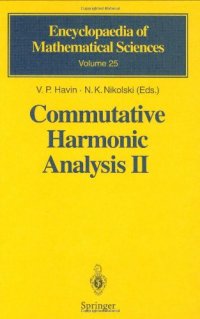
Ebook: Commutative Harmonic Analysis II: Group Methods in Commutative Harmonic Analysis
- Genre: Mathematics // Analysis
- Tags: Analysis
- Series: Encyclopaedia of Mathematical Sciences 25
- Year: 1998
- Publisher: Springer-Verlag Berlin Heidelberg
- Edition: 1
- Language: English
- djvu
Classical harmonic analysis is an important part of modern physics and mathematics, comparable in its significance with calculus. Created in the 18th and 19th centuries as a distinct mathematical discipline it continued to develop (and still does), conquering new unexpected areas and producing impressive applications to a multitude of problems, old and new, ranging from arithmetic to optics, from geometry to quantum mechanics, not to mention analysis and differential equations. The power of group theoretic ideology is successfully illustrated by this wide range of topics. It is widely understood now that the explanation of this miraculous power stems from group theoretic ideas underlying practically everything in harmonic analysis. This volume is an unusual combination of the general and abstract group theoretic approach with a wealth of very concrete topics attractive to everybody interested in mathematics. Mathematical literature on harmonic analysis abounds in books of more or less abstract or concrete kind, but the lucky combination as in the present volume can hardly be found in any monograph. This book will be very useful to a wide circle of readers, including mathematicians, theoretical physicists and engineers.
Classical harmonic analysis is an important part of modern physics and mathematics, comparable in its significance with calculus. Created in the 18th and 19th centuries as a distinct mathematical discipline it continued to develop, conquering new unexpected areas and producing impressive applications to a multitude of problems. It is widely understood that the explanation of this miraculous power stems from group theoretic ideas underlying practically everything in harmonic analysis. This book is an unusual combination of the general and abstract group theoretic approach with a wealth of very concrete topics attractive to everybody interested in mathematics. Mathematical literature on harmonic analysis abounds in books of more or less abstract or concrete kind, but the lucky combination as in this volume can hardly be found.